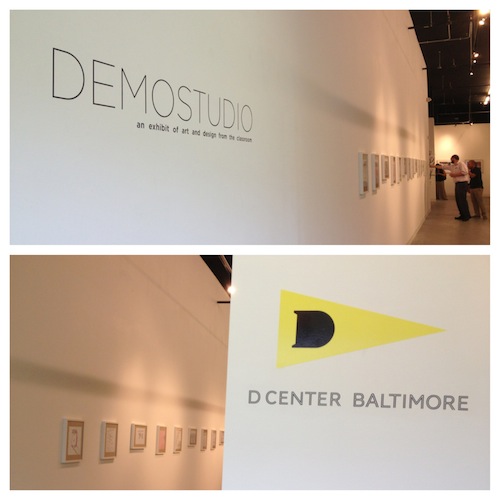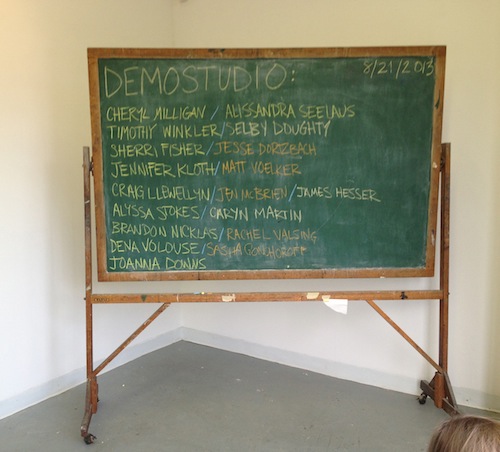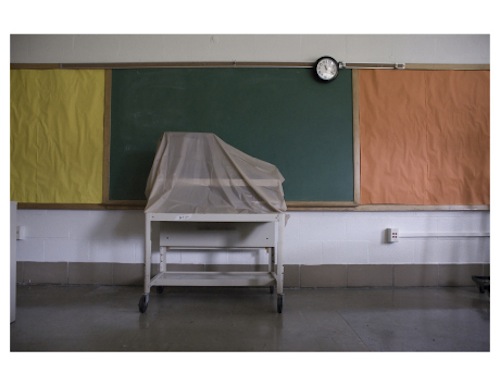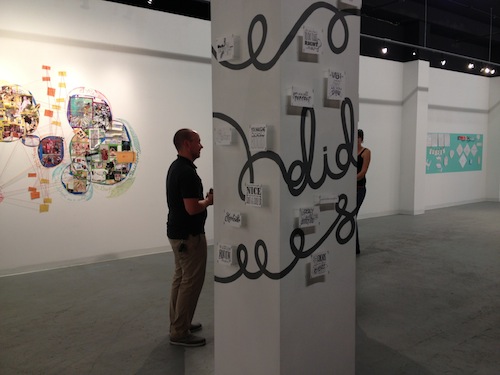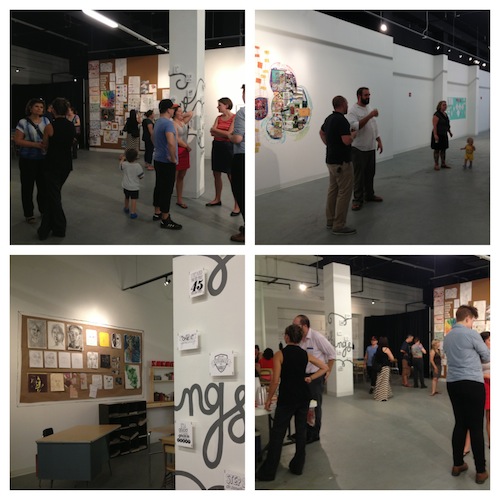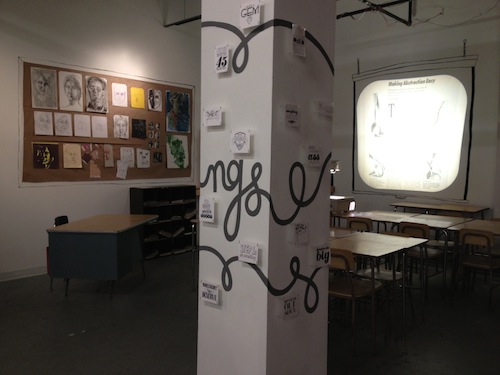When I was in Elementary School our art teacher gave us fat crayons and told us to draw what we did over our summer vacation on manilla paper. We did this every single year. These drawings sucked, not just because the materials prohibited the student-artists from making a range of unique, specific, or experimental marks, but also because they were the result of lazy thinking from a teaching standpoint. Our teacher was not an artist, well, not an inspired one, and we, the students, were not expected to be either.
The good news? Currently, there are a number of K-12 Art Teachers in the Baltimore area who really get it. They might not have a lot of time to create their own artwork, but that doesn’t matter. Like professional artists, these art teachers can cull ‘real’ art from the most uncanny places – in this case, their classrooms.
The new exhibition, Demo Studio, currently on view at D Center Baltimore explores the notion that public school art teachers are artists themselves, and that this practice benefits both the teacher and their students, enriching the educational system exponentially. The exhibition, and an accompanying blog, features work by Cheryl Milligan, Alisandra Seelaus, Timothy Winkler, Selby Doughty, Sherri Fisher, Jesse Dortzbach, Jennifer Kloth, Matt Voelker, Craig Llewellyn, Jen McBrien, James Hesser, Alyssa Stokes, Caryn Martin, Brandon Nicklas, Rachel Valsing, Dena Voluse, Sasha Gonchoroff, Fiona Coulter, Alicia Gauger, Kathleen Mazurek, and Joanna Downs, who are all, presumably, art teachers in public school settings.
What’s interesting about this show is not the fact that art teachers make art and are showing it together, but that they are making art directly inspired from their working environment. In some cases, classroom materials, like handouts, bulletin boards, and student exercises are displayed as the actual art and, in other cases, the artistic output has been influenced by the classroom, but transformed into something new. When you enter the exhibit, you are immediately greeted by several peppy displays of handmade art dittos, and other types of utilitarian classroom signage, framed and hung as art. Confronted with materials that are normally used and disregarded as part of the process to create classroom art, you approach them with a respectful and discerning eye. Not only do you appreciate the sophistication of their content, you also realized that each displays an innovative design, the product of a unique and highly trained individual.
To illustrate this idea even more literally, a makeshift classroom has been assembled in the back of the gallery as an installation by Craig Lewellyn. School-grade desks and chairs have been arranged into art tables, with an overhead projector centrally broadcasting an art lesson onto a hanging screen. In simple black contour lines, a typical classroom background has been painted on the wall, depicting cartoon-like storage cubbies, slop sinks, and giant gallons of pump-able paint sitting on the counter. Two additional bulletin boards have been painted onto each side of the classroom, with a selection of original works by different teachers filling each one. The more compelling wall assemblage goes floor to ceiling and is densely filled with painting exemplars and exercises. The expected color wheels are present, but other, more innovative color exercises are too, like the skin tone match (pictured below) from ‘Ms. Mazurek,’ an enlightening approach not just to painting realistically but appreciating racial differences in the classroom. The classroom installation appears to be a product of a number of different teachers, and used as an opportunity to be inclusive. It could benefit from some editing, as individual works are inconsistent in their quality. However, it is impressive in its scale and specificity to classroom detail and is a thought-provoking challenge to the way artworks are traditionally displayed in a white cube.
Inspired by the physical forms from her classroom, several photographs by Jennifer Kloth capture and abstract the spaces and equipment which surround her. Taken after the school year ands and the materials are packed away, Kloth captures a meditative stillness in her surroundings, reinforced by the simplicity and centrality of her compositions. In one photo, for example, a blanketed audiovisual cart sits in front of empty bulletin boards and a school clock. Although it is a bit forlorn, the photo also captures the creative potential of summer break, and the artist’s ability to see and capture the elegant forms around her.
Other works in Demo Studios mine the relationships between students and teachers. Sherri Fisher’s large multimedia wall installation explores a visual conversation between herself and one of her students, in a collage format. Assembled of snippets of notes, magazine pages, and sketches into several circular formats on the wall, the piece is activated by a dense tangle of colored string, which illustrates a layered conversation and links disparate elements. The piece is a true collaboration, with a section of the piece created by her student.
Alisandra Seelaus depicts a different kind of student-teacher conversation in a text based wall installation that winds around several of the large square pillars in the space. Seelaus layers several different hand-made fonts into a visual dichotomy of phrases she says often to students, and other sayings that occurr to her, that she keeps to herself out of professionalism. Over a twee and loopy cursive, which comes off as a unifying pattern, Seelaus has designed a number of tiny badges on paper, which are pinned over top and make a variety of statements including, “You are a gem,” “You are literally the worst” and “I heard you the first 45 million times.” For those who don’t venture often into schools, it’s a humorous take on the all-too-human conflicts that arise in a classroom and for those who are teachers, it’s an inside joke which might make you laugh out loud.
Demo Studios opened at the least convenient, most busy time of the year for teachers. As all instructors (including me) brace themselves for September and a new school year, this exhibit is a great reminder that the artist inside, the reason we got into this business to begin with, doesn’t need to stagnate because we are heading back to work. We don’t need to put our artist-selves on the back burner in the interest of teacherly altruism. Rather then getting bogged down in syllabi, grading policies, and discipline, artist-teachers can always find ways to be actively engaged with our students and practice. This isn’t a selfish or unprofessional attitude either: this spirit is what keeps the classroom an inspiring and collaborative place, a true learning environment for all participants.
*Author Cara Ober is a part-time professor at MICA and a former High School Art Teacher. She is the editor and founder of Bmoreart.

